

| Home | For sale | Site map | Contact information | Guest book | Stielhandgranate 24 menu |
 Splitterring
für Stielhandgranate Splitterring
für Stielhandgranate  |
|---|
|
The fragmentation sleeve The Stielhandgranate 24 contained 165 grams of explosives, and would have a fatal effect on personnel within a radius of a few meters from the blast. The thin metal casing only gave off a small element of fragmentation. The idea behind the Stielhandgranate 24 was that it was an offensive weapon, and should not be a danger to the user himself. Well into Russia the Wehrmacht quickly found out that the enemy possessed handgrenades with much better effect than their own. 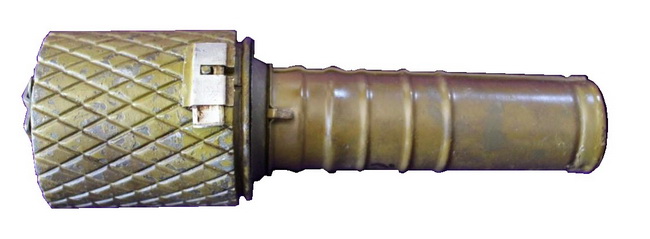 The RGD 33, the Russian equivalent to the Stielhandgranate 24 was an example of this. It had a detachable fragmentation sleeve that could be used when the thrower had good cover, for example when under attack in trenches. The information about this grenade with the detachable fragmentation sleeve was reported from the front directly back to the Reichsführer SS Heinrich Himmler, who had his own informants in the Waffen SS units fighting on the southern part of the Eastern front. And that was the start of the strange story about the fragmentation sleeve for the Stielhandgranate 24. The SS-Waffenamt, responsible for the weapons and equipment used by the Waffen SS, with its leader SS-Oberführer Gärtner was against the idea from the start. A direct order from the Reichsführer SS (RfSS) to develop a copy of the Russian construction was issued on 16. June 1942. In a memorandum dated 11. July the same year the SS-Waffenamt informed the SS-Führungsamt that a fragmentation sleeve already had been developed, but only for use with a mechanism used to launch handgrenades from permanent fortified positions. A fragmentation sleeve for the Stielhandgranate 24 had not been developed due to several reasons. The device would be lethal for all personnel within a radius of 100 meters, not only killing the thrower but all of his fellow soldiers. This would make it unsuitable for anything but trench warfare. Further on it would increase the weight of the grenade, decreasing the throwing distance possible, and it would mean a higher consumption of steel by the industry. According to the document, the RfSS had been informed and accepted the negative information, but had still ordered development and testing of a prototype. The Heeres Waffen-amt was informed about the project on 13. July 1942 and invited to participate, but the Chief of Staff of the Heeres Waffen-amt, Oberst Löhr, was also against the idea, using the same arguments. But on 7. January 1943 a new letter from Oberst Löhr to SS-Oberführer Gärtner informed him that the Heeres Waffen-amt had completely changed their mind; the danger to the thrower was by then viewed as acceptable if he took cover. Due to this, the Heeres Waffen-amt had started developing a model based on the RGD 33 fragmentation sleeve with pre-cut squares. But in the meantime Generalmajor Gerloff of the Technischen SS- und Polizei Akademie had developed a new version that was supposed to be less lethal for the thrower. It consisted of a smooth circular spring with the thickness of 1,5 mm that would be attached to the head simply by the built in tension of the steel. This model had already been shared with the Heeres Waffenamt, but they had obviously decided to develop their own model. Despite this the SS-Waffenamt sent the Heeres Waffenamt 100 examples of their smooth sleeve for trials in January 1943. A head from the Stielhandgranate 24 was set off with a electric detonator, and plywood boards of 20 mm and 40 mm thickness were set up at different distances, used to count the number of hits and penetration ability of the fragments. 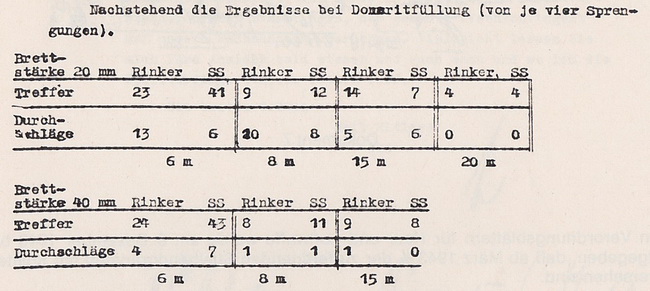 The SS model resulted in more, but lighter fragments, losing its effect beyond 10 meters. The Heeres Waffenamt concluded that the best fragmentation sleeve would be the one developed by Richard Rinker (the Heeres model), as it was decided that the thrower would be using the grenade from cover. The SS model was described as "considerably easier and quicker to manufacture in large numbers", but not likely to wound the enemy standing more than 15 meters away from the blast. The SS Waffenamt and the Heeres Waffenamt ended up with different conclusions, as their criteria were different from the start. The Heer wanted a fragmentation sleeve that would have the maximum of effect, since they would only be thrown by personnel that had sufficient cover in the defensive role. The SS wanted a fragmentation sleeve that would be effective during assault without danger to the thrower.  In a letter dated 18 February 1943 the approbation of the Heeres model was announced by the Heeres Waffenamt "without further trials by the troops". But since the tooling and machinery for the Heeres model would take some time to organize, it was suggested in the same document that production of the SS model should start as soon as possible as a "stop-gap" measure. This lead to the peculiar situation that the procurement office of the Heer actually ordered both models made. 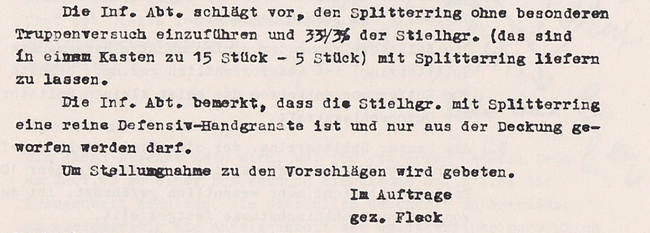 The distribution method and number of fragmentation sleeves had already been suggested in a letter dated 3. February 1943 (above) from the Chef des Heeresrüstung to the Chef des Infanterie. 5 out of the 15 Stielhandgranate 24 in a standard transport box would be pre-fitted with the fragmentation sleeve at the factory. With a monthly production output of up to 1 million Stielhandgranaten 24 this meant a corresponding monthly production of 330,000 fragmentation sleeves. 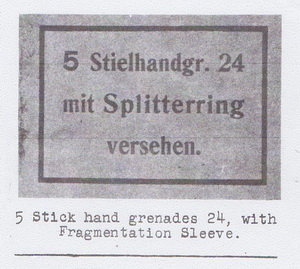 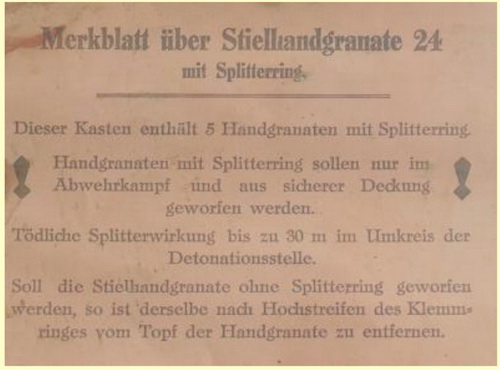 The transportation boxes were marked with the new contents as shown above to the left (this picture was printed in the Recognition handbook for German ammunition, April 1945, published by SHAEF). There was also a loose leaf (Merkblatt) in the box with the appropriate warnings, and instructions for removal of the Heeres model sleeve if the handgrenades would be used without the fragmentation sleeve. Of interest is the much lower "danger zone". When the SS-Waffenamt was against the initial idea with the Splitterring they claimed the radius to be 100 meters, but this warning label claims 30 meters. 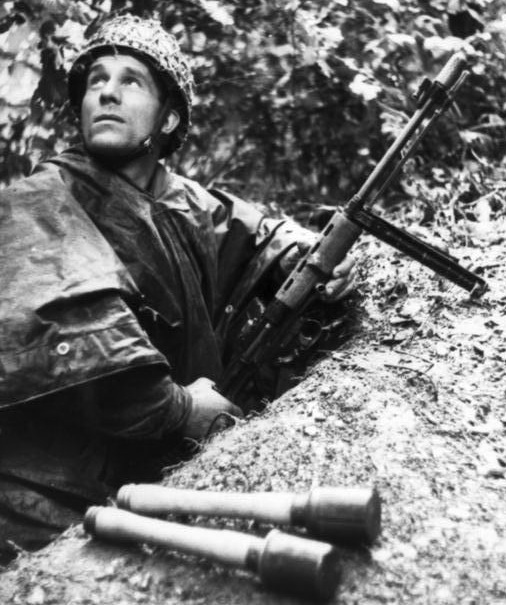 A Fallschirmjäger armed with a FG42 and two Stielhandgranate 24, pictured by Kriegsberichter Arthur Grimm somewhere in France during the summer of 1944. Note that one out of the two handgrenades has been fitted with the SS-model of the fragmentation ring. 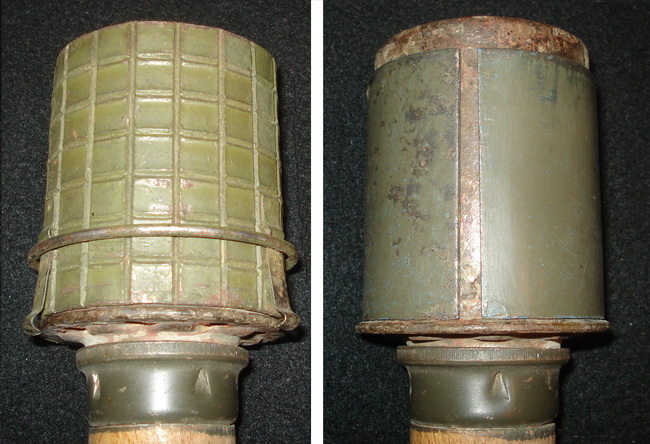 Both models shown above. The Heeres model was manufactured by Richard Rinker in 1943, marked "brb 43", it is shown with the attaching ring open. The SS-model is slightly shorter than the head and held only by the friction created by the spring tension. The sleeve could be pushed all the way down or attached at the end, like the picture of the Fallschirmjäger above shows. Both models are painted ordnance green on both the inside and outside. The SS model carries no marking. 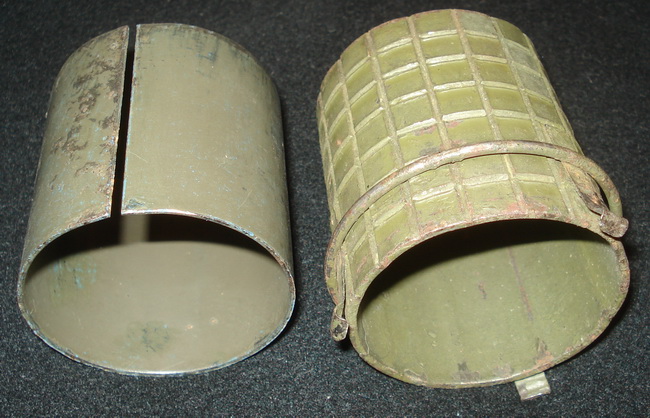 The Heeres model was made from rolled sheet metal of "Thomas-qualität" that was welded to a tubular shape, with the welding seam visible on the inside. It would then be heated and the pattern was rolled into it, creating slightly irregular squares from the displaced metal. Then the ring was fitted, with the three springs in turn spot-welded in position, and finally the whole assembly painted. The maker's code on the fragmentation sleeve was pressed into one of the squares closest to the bottom edge (with the attaching springs). The lower picture above shows the text "Do 3/1944" inked on the body of a brb44 fragmentation sleeve.  The fragmentation sleeve is mounted on a matching 1944 brb (believed to be "as found" in a box of 15). Richard Rinker stamped the explosive contents filling to the fragmentation sleeve after the sleeve was factory mounted to the grenade head, as the details would be unreadable on the 5 Stielhandgranate 24 that were issued with the fragmentation sleeve installed. 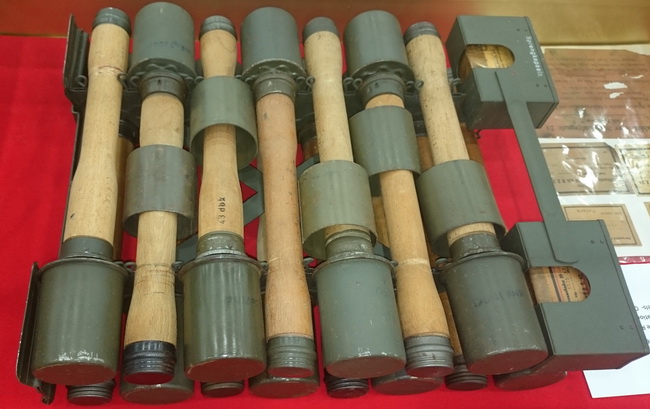 The picture above shows a complete transport frame offered for sale at the SOS 2015. Note how the fragmentation rings of the SS-model have just been put on the handle, most probably by the seller to better display his merchandise. According to the Merkblatt issued in the box of 15, the fragmentation rings would have to be removed if they were not needed (and not installed if needed!). 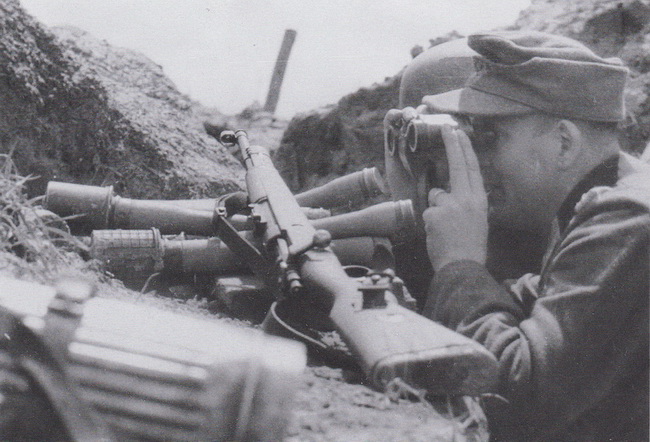 In a trench in the east, 1944. Note the Richard Rinker Heeres model fragmentation sleeve, and the late war Mauser K98k with stamped parts. Updated information I have been sent this very interesting picture as a sign of gratitude from a Finnish curator. 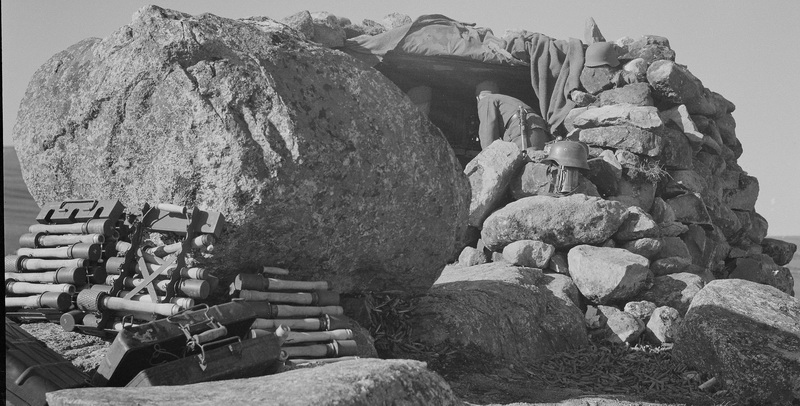 It shows a German position somewhere on the arctic front line between the Russian and German positions. It is most probably the rear side of a MG bunker, as the pile of spent brass in the lower part of the picture is quite impressive. Some spent flare gun cartridges can also be seen. The pile of hand grenades on the left consists of at least 33 grenades visible in plain sight. These are arranged in a haphazard way, with half of them with removed safety covers and pull cords dangling, mixed in with those with the safety cover in place. Quite a few of them can be dated as pre April 1940, as the white stenciling is visible. This leads me to believe that the photo is most probably from the first half of WW2. 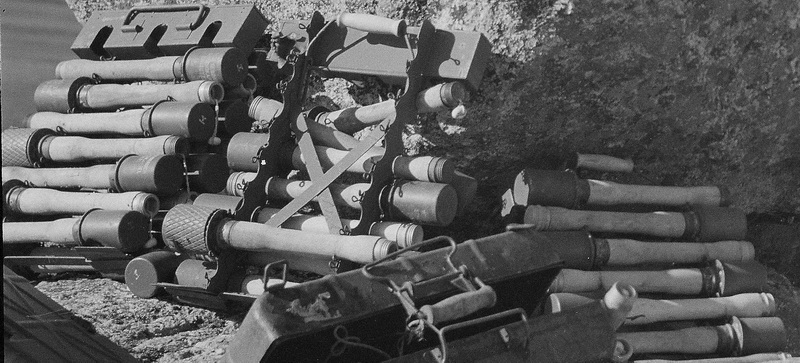 But the most interesting aspect can only be seen when the photo is enlarged. Two of the Stielhandgranate 24 has been fitted with the Russian RGD33 fragmentation sleeve! This means that the German soldiers saw the need for a fragmentation sleeve before the Wehrmacht managed to invent and supply them. They have simply taken the fragmentation sleeves from captured RGD33 hand grenades and attached them to their own grenades by splitting the sleeves to make them wider. Since the RGD33 is slightly smaller the sleeve will not fit a Stielhandgranate 24 right away. It has to be cut open along the axis and forced over the grenade head. How to spot an original fragmentation sleeve The smooth "SS" model can only be appreciated by the external appearance, like rust, paint and markings. Or (valid only for the actual owner) the source it came from. Any smooth ring stamped with a metal stamp must be considered a fake. The only known marking so far is a "mirror" of the text that could be found on the head, describing the explosive contents and date of manufacture. Smooth fragmentation sleeves are extremely hard to judge; "beauty is in the eye of the beholder"! In theory, there are three ways to make the serrated Splittering. -Die cast (never seen one, even not a fake) -Machined from a piece of tubing (pattern milled out with traditional tools) -Forged (heated, and the pattern pressed into it) 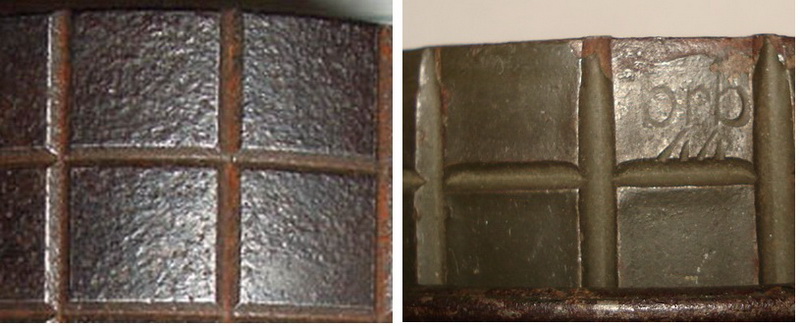 The picture shows the difference between a milled and a forged Splitterring. To tell if the Splittering was forged or milled is very easy! Some talk about even-sized and uneven sized squares, but that is an inaccurate way to tell them apart, as the milled ones could in theory be cut by hand in different sized squares. The difference lies in the technique used. Let's pretend the initial pipe is 1 meter (could have been longer, could have been shorter) The pipe is heated red hot and a set of "v" shaped knives are rolled around the length in one operation. The pipe is then sent through another machine with the same set of knives, but this time they cut along the length all at one time to distribute the pressure evenly. This technique will not remove any metal; it will simply push it sideways, as the knives presses down. The metal will protrude slightly along the edges of each square, giving that "uneven" look. Since the cutting is done in two operations, the last turn of the knives along the length of the tubing will also slightly move the ends of the cut along the length, making the "crossroads" narrower on the circumference, but wide open along the length. The milled one is simply cut with a grinder or file, removing the metal that once occupied the place that the pattern is cut into. A slight "melt-down" will appear at the crossroads if the milling has been done with a high-speed tool, slightly resembling the narrowing of the forged variety, but the raised edges of the squares is impossible to duplicate. 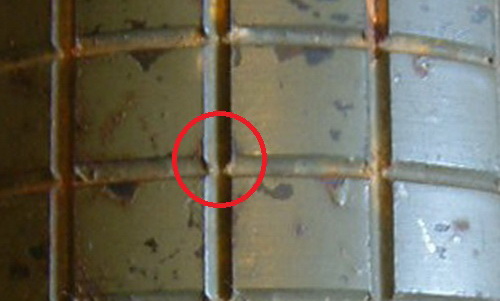 The above picture show the "fake" metal displacement on a milled variety due to high-speed cutting. Note the totally flat squares. Richard Rinker was mentioned in official documents as the initial designer and manufacturer already in January 1943. On 18 February 1943 their model was adopted for production. We even know the specifications for the product. "Fabrikationsbeginn und Liefermöglichkeit der ausgeschweisstem Rohr, Thomas-Qualität mit eingewalzter Riffelung hergestellten Splitterringe hängt von dem monatlichen Bedarf und der Dringlichkeitseinstufung ab." It was made from tubing, rolled and welded, of "Thomas" quality (whatever that means)! The pattern was rolled into it. Addendum! 'Thomas Qualitaet' refers to the Thomas-Gilchrist-Verfahren or the Thomas-Gilchrist-Process in steel manufacturing and the end product is called "Thomas Stahl" in German ("Thomas" Qualitaet).. It is named after the two British metallurgists Sidney Thomas (1850-1885) and Percy Carlyle Gilchrist (1851-1935) (from Wikipedia "Thomas-Verfahren"). Thank you for the information Heinrich! The tubing used for simple items like a fragmentation sleeve or a Panzerschreck was rolled into a tube and then welded. Most of the time so well done that it is impossible to see. There will be lines visible on the inside from the depression of the cutting wheel, but seeing the actual seam from the welding is hard. Extracted tubing (seamless) was a known technique during WW2, but seldom used due to cost and labor. So the initial model and manufacturer was the one that can be found marked brb 43 or 44, of the forged variety. Faking them will be extremely difficult (but not impossible) as it would require some really HEAVY machinery and processes. I have never seen an attempt to fake a sleeve with the forging technique that was looking remotely like the real deal. Any other makers? I haven't been able to find any documents describing other makers, but there is at least one more, and he did not mark the Splitterring with a impressed code. The production method is the same, forged with rolled in pattern. They can most of the time be distinguished from the brb's as the pattern is lighter (shallow) in comparison, but still leaves the raised edges around the squares. 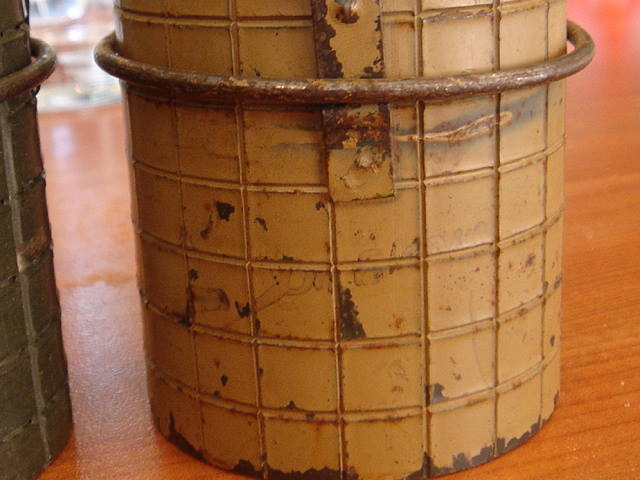 Picture by courtesy of Raoul Lorgé The fantastic Dunkelgelb example above is an example of a Splitterring made by this unknown maker. It was factory fitted to a Stielhandgranate 43, and contains the details about the explosive filling ink stamped to the body, but no makers mark. There is absolutely no available information about a WW2 manufactured variety that was milled. Those observed have been marked "ar 4", "OXO 4", "duv 43", "oxo 44" and unmarked. The first three mentioned all come with sloppy added, not making any sense, plainly faked stampings, and are ruled out by those markings alone. The last two are basically the same, but with or without markings. oxo was the code assigned to Teuto-Metallwerke GmbH, Osnabrück, a company manufacturing small arms cartridges and shells for aircraft machine guns from 1935 to 1945. The Splittering was approved by the Heeres WaA in February 1943. It was a relatively cheap product that required a minimum of machining time and low tool consumption. By 1944 most products in the Third Reich were made as fast and economic as possible, to save labor time and materials. The use of stamped parts on Mausers and the simplified Stielhandgranate 43 to name a few. If the milled Splitterring in fact was made during WW2 it means that a new manufacturer of the Splitterring milled them out instead of the much cheaper and faster forging method. I guess (strictly guessing) that a factory could make at least ten forged ones compared to one milled, at the same price and same time. In 1944 that would mean quite a lot for the supply situation. To make a copy of the forged one is possible, but hasn't been done with any luck as far as we know. there is one on the market, but it looks even crappier than the milled ones. It makes no sense to go those extra miles to make a forged one, as long as people buy the milled ones. Any tool shop in Eastern Europe could make a believable copy of the milled one with simple tools. 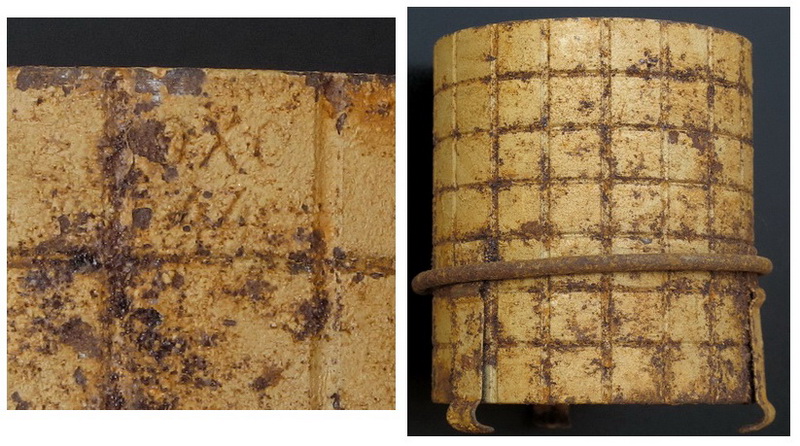 A typical Ebay item. A oxo 44 in Dunkelgelb, with artificial rust added as topping! This one has been sprinkled with chemicals and suspended from a spring to grow that rust so even. If it had been lying underground it would have looked a lot different. The small crystalized pearls of rust that can be spotted in clusters are driven out by the chemicals. Note the area close to the spring, where they forgot to add the chemicals! 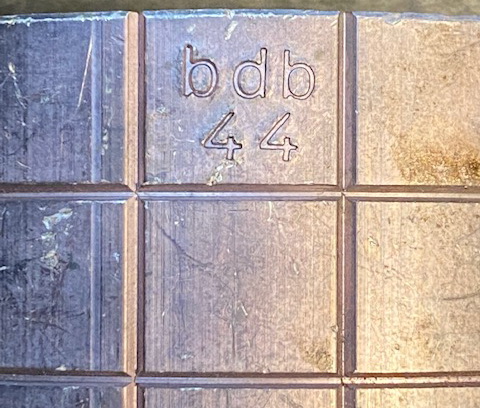 The latest arrival on the market of fakes. This one is unpainted, and the maker has choosen a maker code that is closely resembling the only maker that marked them, brb. But bdb was the manufacturer code of A. Grothe & Söhne, Electrotechnishe Fabrik, a less likely maker of these. Note the milled out squares. Go back to the Stielhandgranate 24 menu |
| Home | For sale | Site map | Contact information | Guest book | Stielhandgranate 24 menu |